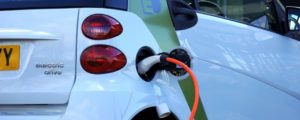
Last week the White House announced an exciting new set of initiatives to accelerate electric vehicle (EV) adoption in the United States. The federal government, working in partnership with state and local governments and the private sector, will take action to increase the number of EVs on the road and, just as importantly, increase deployment of EV charging stations in key locations.
The transportation sector represents 26% of total GHG emissions in the U.S.
The new initiatives include:
- The FAST ACT process to identify and develop optimal corridors for travel and placement of alternative fuel vehicle charging stations
- Making certain kinds of EV charging station installations eligible for federal loan guarantees from the Department of Energy Loan Program Office (LPO)
- The launch of a joint procurement process where state and local government with join the federal government to purchase EVs in bulk at a discounted cost.
Each of these initiatives is a step in the right direction and operate under three essential principles for a successful EV strategy:
- Use the strength of the federal balance sheet to finance state and local activity
- Focus on efficient and optimal deployment of charging stations
- Recognize the complementary nature of EVs and charging stations, deploying both simultaneously
Many state governments have made significant efforts to increase deployment of both EVs and EV charging stations. However state budgets are tight and balance sheets are stretched. Many states use direct subsidies or tax credits to support EV adoption, and similarly pay much of the cost for EV charging stations.
Both efforts have been critical to building an early base of market penetration for EVs, but neither method can scale because of lack of funds. In addition, state subsidies targeting EV purchase, rather than EV usage, are not designed to maximize the desired outcome—EV vehicle miles traveled. And direct payment of EV charging stations misses an opportunity for a more holistic and efficient station network design.
Federal financing is an essential component to EV market growth. The Department of Energy LPO is a good place to start, but more resources that are more easily accessible should be put on the table for state governments. The DOT, the USDA, and the EPA should all make the billions of dollars of funding they have at their disposable for state/local investment available for EV charging station investment. The recently introduced Green Bank Act of 2016 would provide capital to state Green Banks, which in turn could make prudent local investments. A national infrastructure bank could similarly support such efforts.
To maximize the value of public dollars invested, they should be deployed in a manner that takes advantage of network efficiencies. Much like cell phone towers, the location of charging stations can be optimized to serve the most EV drivers with the lowest fixed cost investment. CGC described this approach in a white paper for the New York State Energy Research and Development Authority. States can use innovative reverse auction methods, combined with network optimization to procure EV charging networks from private parties at the lowest cost possible to the public sector. The economics of charging stations today are poor – they are not utilized regularly enough to support debt payments. Therefore public financial support will be necessary, but every effort should be made to minimize that level of support.
And finally, this new set of White House initiatives wisely addresses both the vehicle and the charging station side of the market. This is critical, as both elements of the market must grow together. It is often said the EV market faces a chicken-or-egg problem—unsure of whether charging infrastructure must be built first to reduce range anxiety and enable EV adoption; or if EVs must first be on the road to convince the private sector that charging stations are a good investment. But this framing is inaccurate. Again like cell phones, EVs and charging stations are complementary goods and must exist together, simultaneously. Like a right and a left shoe, there is little value to either an EV or a charging station without the other.
Hopefully this is just the beginning of a major cross-department effort by the federal government to support EV and charging station deployment at the local level. Resources need to be deployed efficiently. Charging station network design needs to be optimized. And federal-state collaboration is essential. These pieces together can draw private investment and bring the EV market to scale.